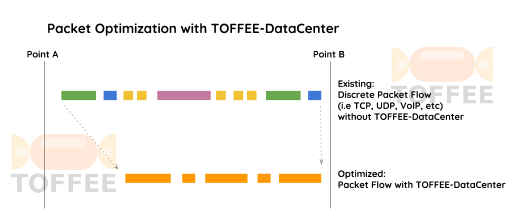Documentación :: Documentación :: Guía de topología de implementación de TOFFEE
Written by: Kiran Kankipati - Published: 14-Dec-2017
Idioma :: Inglés
NOTA: esta página se traduce automáticamente a través de Google Translate. Amablemente ignore cualquier error.
Configuración típica (para usuarios de bricolaje, SOHO, etc.): suponga que tiene dos sitios (como Sitio-A y Sitio-B) conectados a través de un enlace WAN lento/crítico como se
muestra a continuación. Puede optimizar este enlace al guardar el ancho de banda y posiblemente mejorar la velocidad.
Sin embargo, la velocidad WAN puede optimizarse solo si las velocidades del enlace WAN están por debajo de la latencia de procesamiento de su hardware instalado TOFFEE.
Suponga que su enlace WAN es de 12Mbps, y asuma que la velocidad/capacidad máxima de optimización WAN de Raspberry Pi es de 20Mbps,
luego tu enlace también obtendrá optimización de velocidad. Y en otro caso, suponga que su enlace WAN es de 50Mbps,
luego, usar Raspberry Pi como dispositivo de optimización WAN realmente aumentará la latencia (es decir, ralentizará el enlace WAN).
Pero en todos los casos, el ahorro de ancho de banda debe ser el mismo independientemente de la velocidad del enlace WAN.
En otras palabras, si desea reducir los costos del enlace WAN a través de esta configuración de optimización WAN,
siempre puede obtenerlo, ya que reduce el ancho de banda general en casi todos los casos (incluidos los datos cifrados y precomprimidos).
Para obtener más detalles sobre el hardware de instalación de TOFFEE, consulte amablemente: Guía de selección de hardware de TOFFEE

Otros escenarios de implementación de TOFFEE (y / o TOFFEE-DataCenter):
- Implementación de TOFFEE (y / o TOFFEE-DataCenter) con dispositivos VPN: AQUÍ
- Implementación de TOFFEE (y / o TOFFEE-DataCenter) con caché de proxy web: AQUÍ
- TOFFEE-DataCenter una variante TOFFEE para aplicaciones de Data Center: AQUÍ
- TOFFEE-DataCenter como un VNF para NFV: AQUÍ
- Implementación de TOFFEE (y / o TOFFEE-DataCenter) en grandes infraestructuras o redes de ISP: AQUÍ
- Las redes ISP de TOFFEE (y / o TOFFEE-DataCenter) optimizadas (en vuelo/marinas/defensa): AQUÍ
- Las redes de backhaul inalámbricas móviles optimizadas de TOFFEE (y / o TOFFEE-DataCenter): AQUÍ
- TOFFEE (y / o TOFFEE-DataCenter) redes inalámbricas de malla optimizadas - B.A.T.M.A.N [open-mesh.org (Open Mesh)]: AQUÍ
- TOFFEE-DataCenter con GlusterFS Storage Cluster: AQUÍ
- Implementación de TOFFEE Data-Center WAN Optimization en Big Data Analytics: AQUÍ
- Plataforma TOFFEE Data-Center optimizada para Internet de las cosas (IoT): AQUÍ
- TOFFEE-Butterscotch un TOFFEE para el ancho de banda Home/SOHO Internet/WAN: AQUÍ
Aquí hay una perspectiva arquitectónica rápida de cómo TOFFEE-DataCenter optimiza los paquetes discretos entrantes:

Temas sugeridos:
TOFFEE - Optimización WAN
Categories
|
| TOFFEE-DataCenter - WAN Optimization ↗ |
|
| TOFFEE - WAN Optimization ↗ |
|
| TOFFEE-Mocha - WAN Emulator ↗ |
|
| TOFFEE-Butterscotch - Save and Optimize your Internet/WAN bandwidth ↗ |
| 💎 TOFFEE-MOCHA new bootable ISO: | Download |
| 💎 TOFFEE Data-Center Big picture and Overview: | Download PDF |

Saturday' 13-Mar-2021
Saturday' 13-Mar-2021
Saturday' 13-Mar-2021

Saturday' 13-Mar-2021

Saturday' 13-Mar-2021
Featured Educational Video:
Saturday' 13-Mar-2021
Research :: Optimization of network data (WAN Optimization) at various levels:

Learn Linux Systems Software and Kernel Programming:
![Linux, Kernel, Networking and Systems-Software online classes [CDN] Linux, Kernel, Networking and Systems-Software online classes [CDN]](http://sareesaremypassion.org/cdn/the-toffee-project/i/the_linux_channel_banner2.jpg)
Hardware Compression and Decompression Accelerator Cards:

TOFFEE-DataCenter on a Dell Server - Intel Xeon E5645 CPU:





